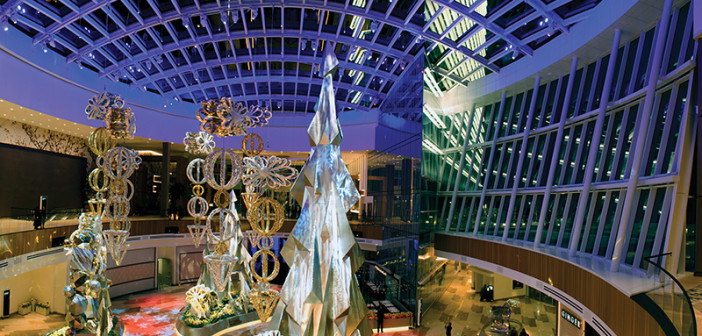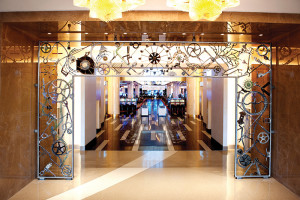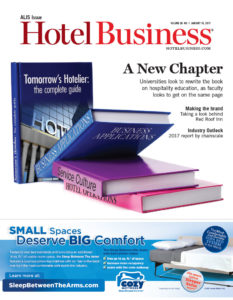NATIONAL HARBOR, MD—While there was once a time that a gambler who wanted to try his hand at the blackjack table needed to hop a flight to Las Vegas or pack up the car and drive to Atlantic City, NJ, those days are long gone. Many states, realizing the potential income possibilities of casino resorts, opened their borders in hopes of generating revenue. Now the market is more crowded than ever, but MGM Resorts International has placed its bets on its newest addition: MGM National Harbor.
Located roughly eight miles from Capitol Hill and just across the Potomac River from Virginia’s Old Town Alexandria, MGM National Harbor represents the first luxury gaming resort in the DC-metro area. “To be able to bring a world-class resort and a world-class brand to an international city like Washington, DC, it’s something like no other. It’s something that this region has never seen before,” said Patrick Fisher, executive director of hotel operations.
“The development of the National Harbor waterfront provided an incredible opportunity for us to introduce the MGM Resorts experience to the Northeast part of the country and introduce our brands to new audiences,” said Anton Nikodemus, COO, regional operations, MGM Resorts International. “The resort’s location is spectacular as it sits along the Potomac with views of Washington, DC, and with access to major transportation, including three major airports, passenger railways, and multiple interstate highways.
“Having a presence in the Capital Region is a tremendous opportunity for MGM Resorts not only to introduce our brand to the market, but also to show what a true destination gaming and entertainment venue is all about,” continued Nikodemus. “With MGM National Harbor, we are exposing millions of people, including influencers in the policy arena and international business and leisure travelers, to the concept. Our expectation is that their experience with the resort will help to broaden their awareness and perceptions of the product that a ‘casino’ company offers.”
The property is located in National Harbor, a mixed-use development that, upon completion, will have one-million sq. ft. of class “A” office space; one-million sq. ft. of retail, dining and entertainment space; and 2,500 residences including townhomes, manor homes, condominiums and apartments. There are currently 2,000 residents and it hosts more than 12 million visitors annually.
Living in the shadow of the nation’s capital, too, will help insulate the property from some of the challenges other non-Vegas properties face. The target demographic for MGM National Harbor includes both locals and travelers up and down the East Coast, as well as international travelers. According to Destination DC, the city welcomed 21.3 million visitors in 2015 (19.3 million domestic and two million overseas). The majority of international travelers came from China, the U.K., Germany and Australia. Fisher noted, “When you have a strong brand like MGM Resorts, it’s an instant draw for those coming to the city. This property will be a beacon and an icon in a city that has so much to offer.”
In one way, he means that literally. “Our property is perched on top of a hill and guestrooms don’t start until you get to the sixth floor, where you’re about 170 ft. in the air already. It expands up to 400 ft., which is as high as we could go with the FAA into Reagan National Airport,” said Fisher. In comparison, he said, “DC has a building height restriction of 110 ft. so we’re able to offer guests everything they want downtown, but can’t get—the views.”
While the LEED Gold-certified property aims to have widespread appeal, it was very much built with locals in mind. A native himself—Fisher attended high school in Prince George’s County, where the resort is located—MGM wanted to have community buy-in on the project and an impact on its locale. “We made big commitments five years ago to the community at large, and I’m happy to report we haven’t just met those commitments—we’ve exceeded them,” said Fisher. The company had a hiring goal of 40% in-county. After receiving 50,000 applications, it finished with 48% being all in-county hires. Nikodemus added, “The resort’s proximity to the nation’s capital also provides us with a rich, diverse community that has allowed us to build a dynamic workforce that reflects our commitment to inclusion.”
That diversity, Nikodemus said, is extremely important to MGM. “How we do business is just as important as the business we bring. Our customers and the communities in which we operate both acknowledge the importance of our company’s emphasis on diversity and inclusion, in our offerings, our management and our workforce, combined with our commitment to the environment as key factors in why they choose to work with us and play with us,” he said.
Echoing Nikodemus’ thoughts on the property influencing those in the policy arena, Fisher noted the resort could have a huge impact on the gaming industry as a whole. “You’re really going to reshape the concept of gaming, especially in DC where you’ll have lawmakers on the Senate and the Hill where they’ll be able to come and see something that’s so much more, to really open their eyes and grow and expand the gaming industry,” he said, noting that seeing something up close is always beneficial. “We see that through our sales groups as well. It was one thing to talk about it and show renderings, but as soon as they get in the space, they’re immediately grabbed and taken to a new level. It’s an instant sell.”
A self-described Vegas-style hotel, Fisher sees it as “so much more than a casino.” The $1.4-billion property offers 308 rooms, including 74 suites; 15 F&B concepts from celebrity chefs like José Andrés, Marcus Samuelsson, and Michael and Bryan Voltaggio (who are also locals, having grown up in Frederick, MD); The Theater, a 3,000-seat entertainment venue featuring performers like Bruno Mars, Cher, Sting, Lionel Richie, Duran Duran and Panic! At the Disco; two nightlife concepts from Clique Hospitality; the two-level, 27,000-sq.-ft. Spa & Salon with 11 treatment rooms, a full-service salon and barber shop, among others; a retail district featuring high-end luxury stores, including SJP by Sarah Jessica Parker, the first standalone boutique from the actress/designer; and an art program featuring more than 70 local and national artists, including Alice Aycock and John Safer, in addition to a sculpted iron archway designed by folk legend Bob Dylan—his first permanent display of public art.
Of course, the property does also have gaming. The 125,000-sq.-ft. casino features an Asian gaming pit with 16 Macau-style Baccarat tables; 3,300-plus slot machines; 126 table games; a 39-table poker room; a luxury high-limit gaming room; and semi-private salons.
According to Fisher, the crowning jewel of the property is The Conservatory, a 15,000-sq-ft. floral attraction created by designer Ed Libby that changes seasonally. “It’s 33% larger than our Bellagio sister property in Vegas,” he said. “It’s really the centerpiece of the property. It’s really an over-the-top spectacle.
“We listened to our guest. We heard what they want from within the DMV region,” continued Fisher. “It’s Las Vegas meets DC with refined elements, little local touches.
“We are able to introduce something that hasn’t existed in the Maryland gaming market, or in the entire Capital Region, to date—a destination resort, where under one roof guests can enjoy world-class entertainment, incredible dining, a luxury hotel with a premier spa experience and great retail offerings,” said Nikodemus. “To have all this in one location makes MGM National Harbor a destination in and of itself, in a region with some of the most highly visited destinations in the world.”
While the majority of the company’s resort assets are in Vegas, MGM does have international properties, as well as a few other regional ones, including the recently acquired Borgata Hotel Casino & Spa in Atlantic City. It is also developing MGM Springfield in Western Massachusetts, which is set to open in 2018. Part of a multi-use plan to revitalize the area, Nikodemus noted it will contribute to the economic redevelopment of the city and region, providing thousands of jobs and serving as a strong community partner. “As a company, MGM Resorts is always seeking new ways to enhance and grow our business. This includes exploring new markets in the U.S. and abroad that are rife with opportunities to support the development of an entertainment and gaming destination resort, where MGM can make sustainable contributions to the local economy and community.” HB



